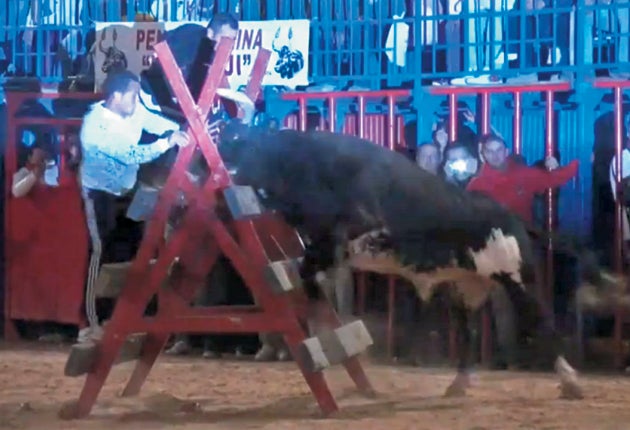Bloodthirsty revellers rush to see Mouse, the 550kg raging bull who's fighting back
After killing three people, Rató* is becoming a star. By Mike Elkin in Madrid

Your support helps us to tell the story
From reproductive rights to climate change to Big Tech, The Independent is on the ground when the story is developing. Whether it's investigating the financials of Elon Musk's pro-Trump PAC or producing our latest documentary, 'The A Word', which shines a light on the American women fighting for reproductive rights, we know how important it is to parse out the facts from the messaging.
At such a critical moment in US history, we need reporters on the ground. Your donation allows us to keep sending journalists to speak to both sides of the story.
The Independent is trusted by Americans across the entire political spectrum. And unlike many other quality news outlets, we choose not to lock Americans out of our reporting and analysis with paywalls. We believe quality journalism should be available to everyone, paid for by those who can afford it.
Your support makes all the difference.For more than a century, Spaniards have killed bulls in the ring as part of the country's "national fiesta". One bull is fighting back and not taking prisoners. On Saturday night in Xàtiva, near Valencia, a bull named Mouse killed a 29-year-old man at a festival in which revellers enter the ring with the bulls, taunt them and try to avoid them as they charge. The victim had been drinking, according to press reports.
The man's death would be labelled an accident and likely forgotten if not for the bull that killed him. The 10-year-old, a 550kg bull whose white triangular patch on his forehead likens a spearhead, has now killed three people and injured dozens over the past five years. As a result, Ratón – which means mouse in Spanish – sells out festivals and hundreds of thousands watch his YouTube videos. "He is a killer," Jesús Esteve, who faced Rató* once, told El Pais newspaper. "He waits for you to make a mistake and then he wallops you. And he doesn't let up."
Although calls and an email to Ratón's owner, former bullfighter Gregorio de Jesús, were not answered, it has been reported that he charges up to €10,000 per appearance, five times the normal price. Festival organisers are happy to pay because they know they can boost ticket prices and still sell out. Everyone wants to see the killer bull. There are even groups of men who follow Rató* from fiesta to fiesta to face him.
"People want to see danger," said Mariano Aguirre, president of the Royal Spanish Bullfighting Federation. "I wouldn't go near Ratón, but there are people in the Valencia region who treat this like a religion. The tradition is passed down from grandfather to father to son. But authorities should be careful about who is allowed into the ring, because most of the people killed or injured have been drinking, haven't slept much, or think that they are younger than they actually are."
Ratón's first kill, a 54-year-old man, came in 2006 in Puerto de Sagunto. The town brought Rató* back the next year. But this morbid fascination that has made him a star could prove a further blight on bull-related festivities.
"This is symptomatic of bullfighting in general over the last 20 years, which is that despite all the talk of culture and art, what people want to see is danger and blood," said Alessandro Zara, spokesman for the Equanimal Foundation, a Madrid-based animal rights group. "And using this bull over and over again is even more dangerous, because the bulls learn. That is why in many places it is forbidden to use bulls more than once."
The presence of bulls in local festivals, from the small towns to the massive runs of Pamplona, is as omnipresent in a Spanish summer as the heat. There are roughly 22,000 runnings of the bulls each year, and even more bull-related activities. Despite bullfighting's waning popularity – only 30 per cent take an interest, according to polls – the local festivals do ingrain Spaniards with the bull culture.
"It's very hard to explain this tradition to someone who wasn't born here," Mr Aguirre said. "For instance, in my village sometimes the water supply is cut or the power goes out, and we deal with it. But there's no way we could have a fiesta without the bulls. It's part of our blood."
Join our commenting forum
Join thought-provoking conversations, follow other Independent readers and see their replies
Comments